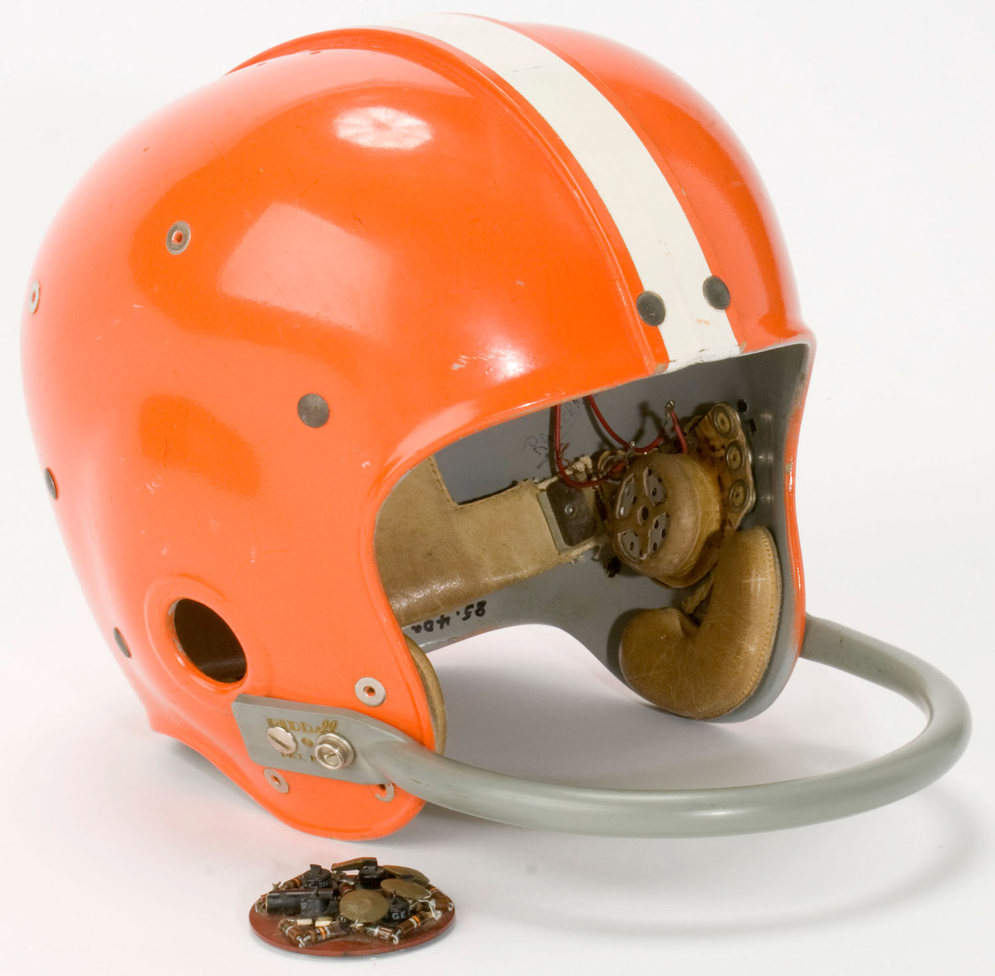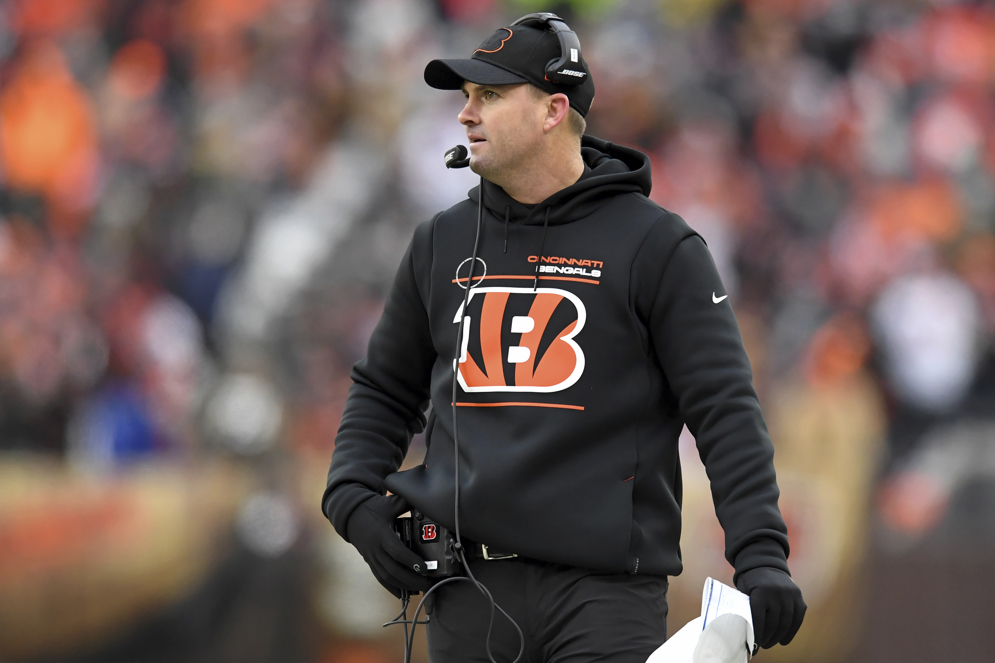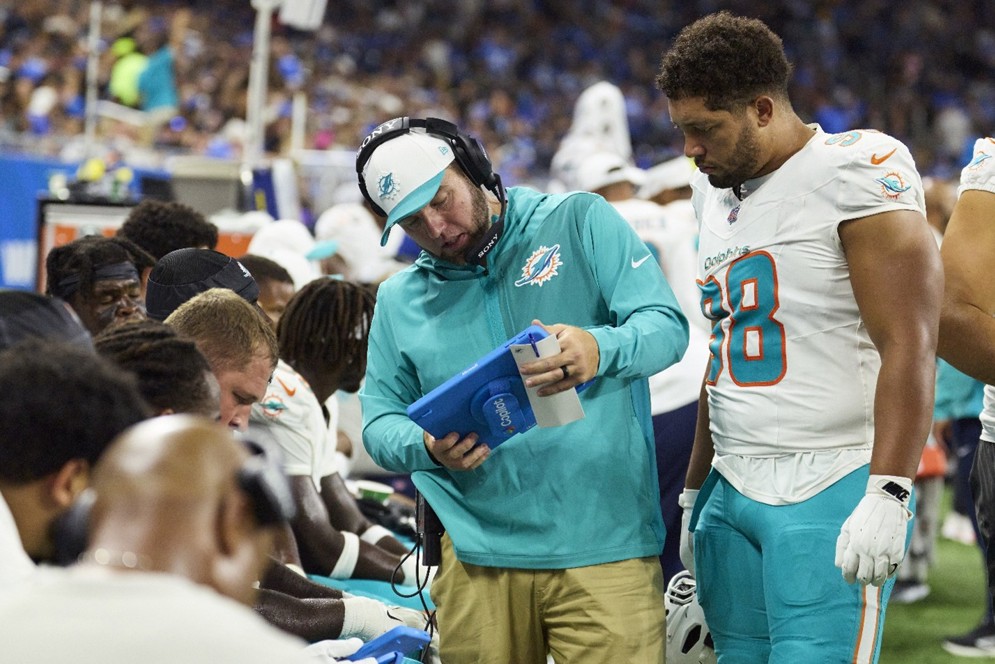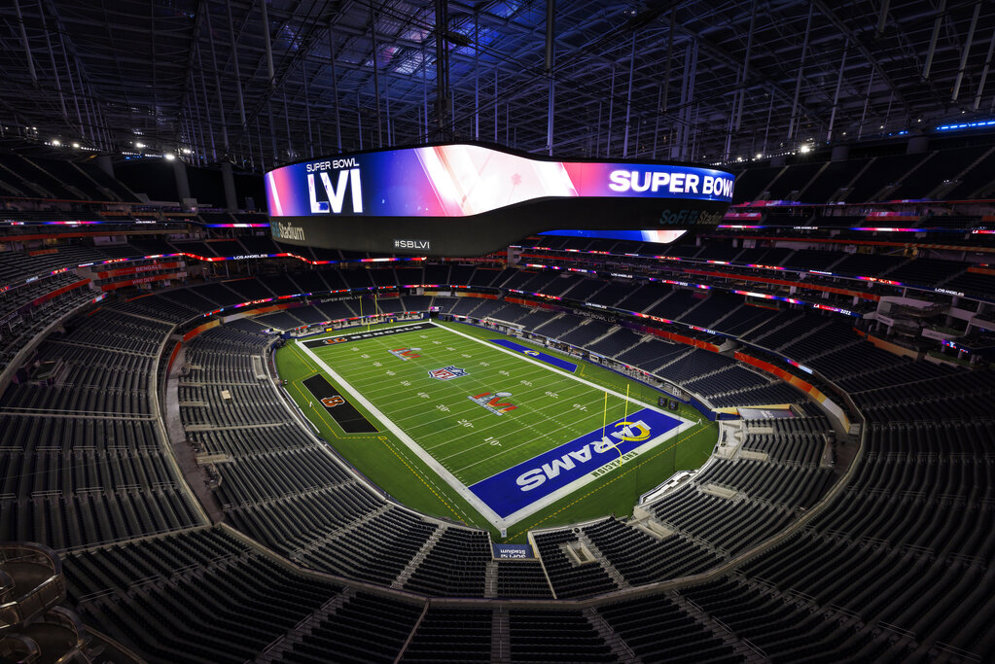Technology and the Game
In the NFL, balancing technology with tradition.
In the NFL, balancing technology with tradition.
Fans are certainly aware of how technology has changed their experience of watching games. They may not always notice, though, how technology has changed the game itself — for the betterment of the league, coaches and players, and even the fans.
Television may have changed the league more than any other technology, and it certainly enabled many of the league’s biggest advancements. It fueled the dramatic increase in the NFL’s popularity and profitability. The instant replay system emerged from — and was a result of — improved broadcast technology. Teams use footage to teach and coach players, and the league uses it to evaluate officials. Television also has led clubs to upgrade stadiums — including the installation of enormous video displays — to compete with the viewing experience at home.
Television is not the only technology to have affected the game. Advancements have allowed the NFL to evaluate and improve officiating and protect players from unnecessary risk. Technology helps players and teams communicate and gives coaches the tools needed to create game plans and to adjust them on the fly.
It speeds up the pace of games, ensures that each contest runs fairly and smoothly and improves the fan experience — for those watching on television and those at the games.
State-of-the-art technology powers the Art McNally GameDay Central, where the league uses to monitor games and evaluate its officials, drives the instant replay system that assists officials in getting calls right. Similar technology enables the wireless communications coaches, players and officials use during games.
Technology provides players with electronic playbooks and position-specific game film on club-provided tablets. As the game unfolds, coaches can dissect opponents’ offense and defense on league-provided tablets.
Technology also helps better protect the players from unnecessary risk. Its impact is felt in consistent playing surfaces and more advanced pads and helmets. It allows teams to keep electronic medical records to better treat players and allows certified athletic trainers to use video to spot possible concussions and other potential injuries during games.
This technology also presents challenges for NFL Football Operations staff. It can be particularly demanding on gameday, when it all must operate smoothly for a fast-paced, time-sensitive, live event that at best is unpredictable and is sometimes played in inclement weather. Making it all work requires attention to detail and the technical knowledge to troubleshoot promptly.
Game Operations staff are responsible to ensure that each system is operational before a game, identify and address potential violations or conflicts, and address technological problems, even as the action continues. A vast amount of coordination is required — not only internally, but also with teams, broadcasters, game day and stadium staff and emergency services.
Each week, NFL event frequency coordinators must navigate countless spectrum conflicts. Licensed bandwidth from the Federal Communications Commission continues to shrink as demand continues to grow. Frequency coordinators ensure anyone using a wireless microphone, walkie-talkie or radio is on the correct channel to allow as many people as possible to access the bandwidth they need. Without this, the long list of people who need to access the spectrum each game could find themselves battling over the same frequencies and unable to perform their jobs properly.
NFL-designed hardware will debut in 2025 that will take coach-to-player communications to the next level, improving audio intelligibility in the extremely loud environment of an NFL stadium.
In addition to reducing the size of the audio helmet components, the improvements require no adjustments to padding in the helmet and moves the speaker module closer to the ear.
The NFL technology team also developed an app that connects to these radio modules wirelessly, so club equipment managers can oversee them on gamedays, enabling players to focus on performance.
The enhanced design secured all health and safety and helmet manufacture approvals and performed well in a series of tests, from the lab to an NFL practice environment, postseason collegiate all-star games and spring football, as well as in non-game day testing at various NFL venues both in the United States and around the world.
“The NFL has a long tradition of embracing technology and innovation to enhance the game,” said Nik Stamatakis, NFL senior director of football technology innovation, research, and development. “We have pushed the envelope with this initiative by engineering the smallest digital mobile radio receiver in the world with the goal of continuing to improve the experience for players that utilize this critical in-helmet communications technology.”
The experiment with electronic coach-to-player communications began in 1956. According to the Pro Football Hall of Fame, that is when Ohio inventors John Campbell and George Sarles presented Hall of Fame coach Paul Brown of the Cleveland Browns with a radio receiver they had developed. They suggested Brown place the device in the quarterback’s helmet and relay calls to him directly, rather than sending in plays with substitute players.

This radio helmet, which two Ohio inventors devised for Cleveland Browns coach Paul Brown in 1956 so he could radio plays in to his quarterback, was banned shortly after its first use. But the NFL embraced an improved coach-to-quarterback communications system nearly 40 years later. (Pro Football Hall of Fame)
Brown first used the system secretly in an exhibition game against the Detroit Lions. The Lions’ coaching staff noticed that Brown was not substituting players as he usually did, and eventually spotted the transmitter behind a wooden light post on the sideline.
Other teams scrambled to devise their own units, but none were as effective as the Campbell-Sarles version. Even that device encountered technical issues. For example, the quarterback intermittently heard a nearby taxi dispatcher instead of the head coach. The Browns used radio helmet technology in three more games before NFL Commissioner Bert Bell banned its use leaguewide.
In 1994, with coaches still using hand signals and player substitutions to call plays, the NFL approved a new version of the system, available to all teams. Once again, coaches could communicate directly with quarterbacks between plays.
Why the change? The previous year, the league cut the play clock from 45 seconds to 40, but instead of speeding up the game, the change slowed it down. Teams had to call more timeouts because they were running out of time sending substitutions in with play calls for the quarterbacks. NFL officials hoped that the new communication system would help speed up the pace of the game.

Coach-to-quarterback communications systems replaced hand signals and player substitutions as methods for coaches to relay play calls to quarterbacks. (AP/Nick Cammett)
The new system did reduce the need for timeouts, saving teams eight to 15 seconds on play calls, Marty Schottenheimer, then the coach of the Kansas City Chiefs, estimated at the time.
Letting every team use the system eliminated the competitive advantage that Brown initially sought in the 1950s. The system benefited from newer technology, along with better reliability and security: Messages now could be scrambled to keep other teams from listening in.
Since then, the coach-to-player communications system has become a fixture, and the NFL continues to improve and refine it.
In 2008, for fairness and defensive play-calling security, the league allowed the system to also be used between a coach and a designated defensive player. In 2012, the headset signals switched from analog to digital, reducing interference and improving the sound quality (making it sound more like a phone instead of a walkie-talkie).
In 2014, after two years of testing, the league equipped all on-field officials with headsets so they can communicate with each other wirelessly, enabling them to coordinate more effectively before plays and discuss penalty calls more quickly after them.
The first use of instant replay in an NFL regular-season game between the Chicago Bears and Cleveland Browns gave the Browns a touchdown, overturning the initial ruling on the field that the ball was recovered out of bounds.
Instant replay as an officiating aid follows a similar trajectory: The league did not fully embrace the system until advances in technology improved its effectiveness, integrity and impact on the length of games.
The league first tested instant replay during the 1978 preseason but waited until the 1986 regular season to adopt it. The first time it was used, in a regular-season game between the Chicago Bears and the Cleveland Browns, it confirmed a call that a Browns player had recovered a botched Bears snap in the end zone for a touchdown.
The league rescinded the instant replay system in 1992, citing its impact on the length of games and complaints that reviews could be initiated only by an instant replay supervisor, not a coach or official.
The technology was not up to speed either. Referees were notified by pagers equipped with mini-microphones when a supervisor initiated a review. The system was cumbersome and inefficient — but it was an improvement over the walkie-talkies that were initially used by the replay official and the referee.
In 1999, the league brought back instant replay with better technology and communications tools, as well as revisions to review rules. And the technology continues to improve. The high-definition video that came into use for replay in 2007, combined with freeze-frame capability and television cameras covering the game from all angles, has given officials an unprecedented ability to get the calls right.
Since the return of instant replay, the league has continued to expand the types of plays that are automatically reviewed or subject to a coach’s challenge. In the 2014 season, new tools and proprietary NFL Vision software enabled officiating supervisors at Art McNally GameDay Central in New York to begin reviewing plays and talk to the stadium instant replay official and the game’s referee well before he or she goes under the hood. That shortens the length of a replay review.
At the start of the 2021-22 season, the NFL installed Hawk-Eye’s SMART system in AMGC, and stadium replay booths across the league. With the technology, replay officials at the stadium and AMGC staff in New York can review multiple camera angles at the same time throughout the game and during replay reviews.

Coaches can use Microsoft Surface Copilot+PCs to view high-resolution color pre-snap and post-snap images instead of showing players static black-and-white photos. (AP Photo/Joe Robbins)
In 2014, the league introduced Surface tablets and the Sideline Viewing System to NFL sidelines.
During games, coaches previously received faxed black-and-white bird's-eye view images of offensive and defensive formations to analyze on the sidelines between each series. Now, they get high-resolution color still images transmitted immediately to secure tablets, allowing them to zoom in and annotate on the screen while instructing their players. The devices also contain a whiteboard for users to draw up plays and a stats feature that loads game stats in near-real time.
Starting in 2025, devices on the sidelines and in the coaches’ booth have been upgraded to Surface Copilot+PCs, delivering faster performance, longer battery life, and native AI capabilities. New AI-powered filtering enables players and coaches to quickly find key moments in real-time—reducing manual searches, accelerating reviews, and highlighting pivotal plays like scoring drives, turnovers, and penalties.
In the coaches’ booth, a Microsoft 365 Copilot-powered Excel dashboard on a helps club analysts identify actionable insights faster to influence game strategies — such as personnel groupings and snap counts.
The tablets are provided to teams before the start of each game and are configured so teams cannot access the Internet or install anything that might give them a competitive advantage; they can only be used for coaching. The league collects the tablets as soon as the game ends, and they are stored until the next week.

Los Angeles' SoFi Stadium's video board is an example of how teams use technology to enhance the game experience. (AP/Ryan Kang)
What’s next? In a sense, in the ever-evolving NFL, the future is already here.
The NFL has used radio-frequency identification (RFID) transmitters (tags) using a system developed by Zebra Technologies. The league has permitted transmitters (tags) to be placed in each player's shoulder pads since 2014. Receivers installed throughout the stadium will use those transmitters (tags) to collect data on each player’s position, speed and distance, in real time, during the game. RFID transmitters are placed inside game balls to further measure location and performance data.
While the technology could be a boon for broadcasters, the NFL envisions its potential extending to team training, scouting and evaluation. Its universal application will hinge on how well the system works initially, agreements with the players’ union on how it can be used, and discussions with players and coaches about whether or how it could benefit them for training and instruction.
In stadiums, the league encourages clubs to provide a technologically rich gameday experience for fans. This includes showing action and replays on enormous screens, making it easier to use smartphones and other devices by enabling better access to Wi-Fi, and providing real-time updates on fantasy football statistics and other games.
For players, the NFL has been considering and testing the use of head impact sensors, trying to determine whether they can feasibly and reliably provide data that can be used to protect players and improve the design of equipment.
The measurements often add drama to the game — the anticipation and the tension building as the officials stretch the chains. The NFL’s Game Operations Manual even mandates that chain crews and players stand away from the front stake during the measurement to allow stadium fans and television cameras to see it.
These are the types of values that the NFL, as the steward of the game, must consider as traditions bump up against technology.